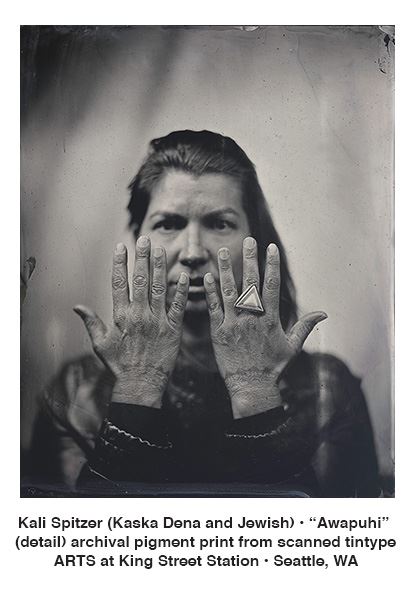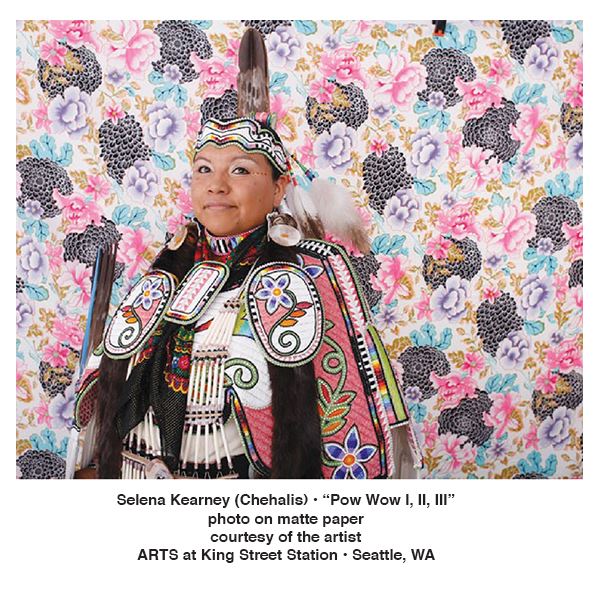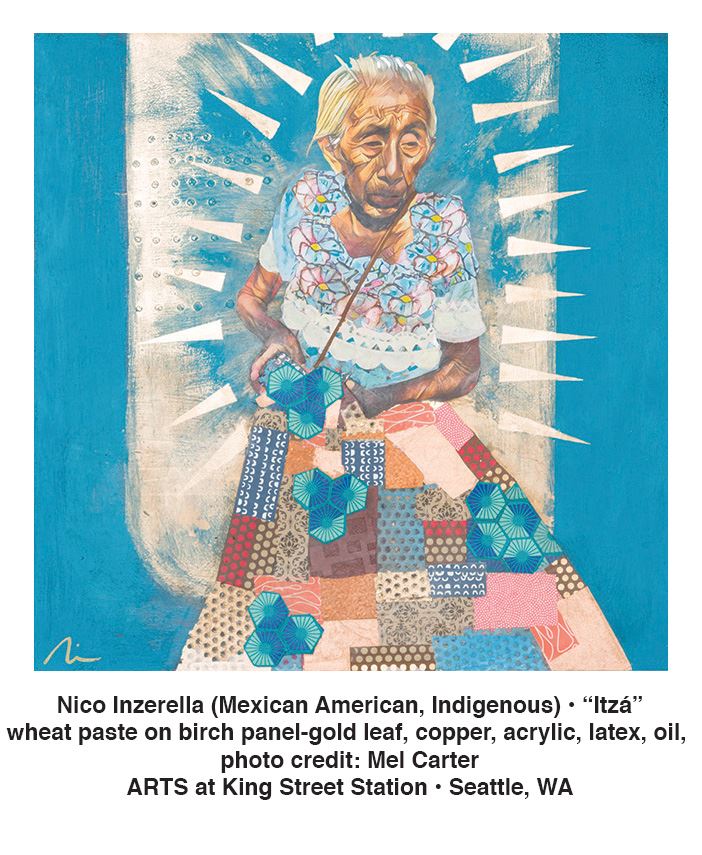
A dazzling exhibition of contemporary Indigenous art awaits you at the newest art space in town, ARTS at King Street Station. The Seattle Office of Arts and Culture launched their new 7500 square foot exhibition space with an exhibition of 200 indigenous artists from 100 tribes. This exhibition curated by Asia Tail (Cherokee), Tracy Rector (Choctaw/Seminole), and Sapreet Kahlon, accepted all indigenous submissions: children and elders, professional artists and beginners, all media from traditional cedar, bead work and dolls to digital and audio. We see sculpture, painting, photography, printmaking, text, cartoons, games, performance, skateboard, drums, maps. There are iPads with music, poetry and stories recited from speakers, and both hilarious and serious videos.
 Installing such a diverse show challenged the curators and staff of ARTS as they organized hundreds of art works succeeded in creating a spectacular result. To enjoy the exhibit simply embrace its mind-expanding diversity, then immerse yourself in one wall at a time, each a compact exhibit. Gaps between the walls allow a view through to another part of the exhibition. The entire space is activated by sculpture and installations, many encourage interaction.
Installing such a diverse show challenged the curators and staff of ARTS as they organized hundreds of art works succeeded in creating a spectacular result. To enjoy the exhibit simply embrace its mind-expanding diversity, then immerse yourself in one wall at a time, each a compact exhibit. Gaps between the walls allow a view through to another part of the exhibition. The entire space is activated by sculpture and installations, many encourage interaction.
At the opening Timothy White Eagle (White Mountain Apache) performed “Songs for the Standing Still People” within a space hung with jingles and chains. He called us to action against the “vast forces” that “will ravage us if we do not act” though a story of rocks that came together and changed the world. We can create our own music in the space and thus join his call to action.
A giant deck of cards by Roldy Aguero Ablao (CHamoru) greets us at the entrance, along with a seemingly random accumulation of objects hanging over the front desk by Catherine Cross Uehara (Uchinanchu/Hapa/Okinaway American), “between you & me & the Ancestors…” includes photographs of her ancestors, a wedding dress kimono, memorabilia, and much more.
On the opposite wall is a film of the famous Vi Hilbert, (Upper Skagit) who singlehandedly saved the Lushootseed language from extinction, encourages a community audience to “lift the sky” together. In her telling: “The Creator has left the sky too low. We are going to have to do something about it, and how can we do that when we do not have a common language?…We can all learn one word, that is all we need. That word is yəhaw̓—that means to proceed, to go forward, to do it.”.psd)
.jpg)
We are invited to go forward into the exhibit in order to create community.
We immediately encounter the compelling painting of Itzá by Nico Inzerella (Mexican American, Indigenous) in the complex mixed media of wheat paste on birch panel, gold leaf, copper leaf, oil, latex and acrylic. Pay attention to media in this exhibit, it is almost always unusual.
At the same time, traditional photography includes striking results such as Selena Kearney’s (Chehalis) photograph of a young woman proudly dressed for a PowWow, Adam Sings in the Timber’s (Apsáalooke) photographs of women in regalia re-asserting indigenous presence in various locations in Seattle and the eerie images of scanned tintypes by Kali Spitzer (Kaska Dena).
 Spend the time to explore the various subtle works hanging on walls, but don’t miss the entire corner devoted to stunning cedar hats, baskets, skirts, and capes.
Spend the time to explore the various subtle works hanging on walls, but don’t miss the entire corner devoted to stunning cedar hats, baskets, skirts, and capes.
Not far away another type of weaving hovers over us. A twelve foot high “Big Foot” hovers over us as it “Lifts the Sky.” HollyAnna “CougarTracks” de Coteau Littlebull (Yakama/Nez Perce/Cayuse/Cree) upcycled 15,190 pieces of plastic to weave this giant. She explained that it represents the wasted past in its orange/red hued back and the future in its green/ blue front.
Be sure to look in the stairwell for a mixed media homage to weaving by Sara Siestreem (Hanis Coos/Confederated Tribes of Coos/Lower Umpqua/Siuslaw) “Eagle Machine dancing<<<<<the beautiful” combines a cotton wood bark skirt with her photographs and mixed media references to indigenous history.
Nearby is Priscilla Dobler’s (Mayan) “El renacimiento de la Sociedad: The rebirth of society,” a traditional Mayan embroidery unravels into a contemporary geometric enclosure; above it hangs Jacob Johns’s (Hopi) “Water is Life” banner that speaks of freeing the Snake River, a reference to our threatened salmon and orcas because of the many dams on the Snake.
Susan Noyes Platt
Susan Noyes Platt writes a blog www.artandpoliticsnow.com and for local, national, and international publications.
yəhaw̓is on view through August 4 at ARTS at King Street Station located at 303 S. Jackson Street, Top Floor, in Seattle, Washington from Tuesday through Saturday, 10 A.M. to 6 P.M. and First Thursdays, 10 A.M. to 8 P.M.
For information, visit www.seattle.gov/arts/experience/galleries/arts-at-king-street-station-gallery. Films and other exhibit all over town check https://yehawshow.com.